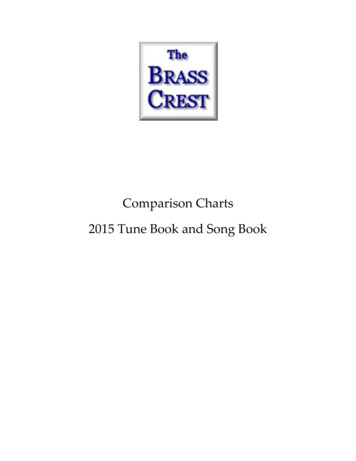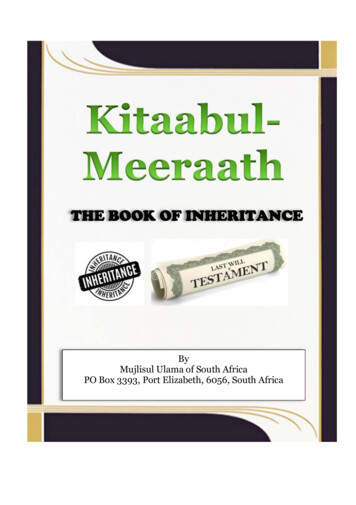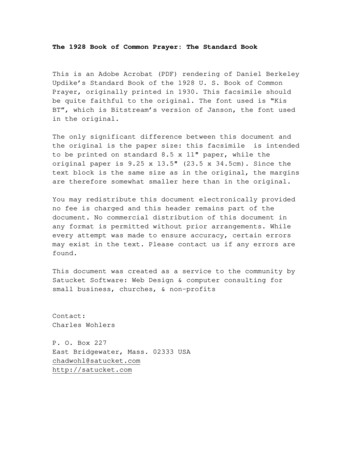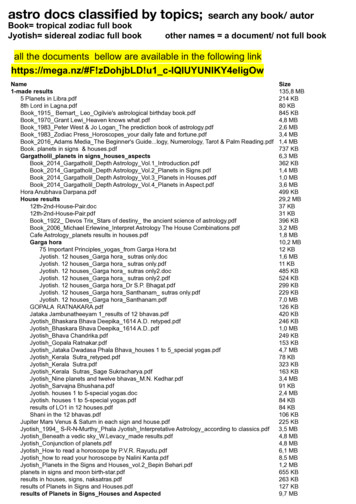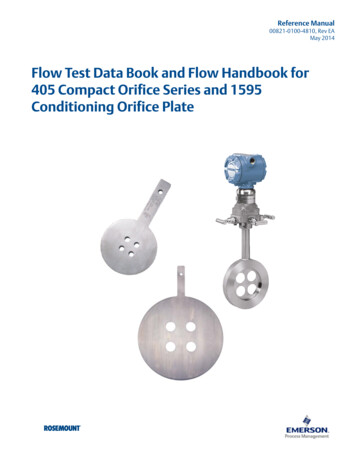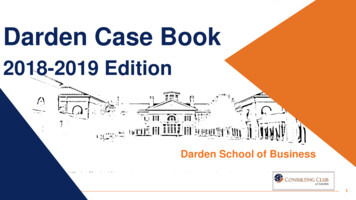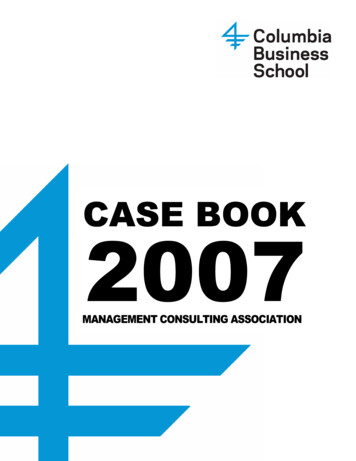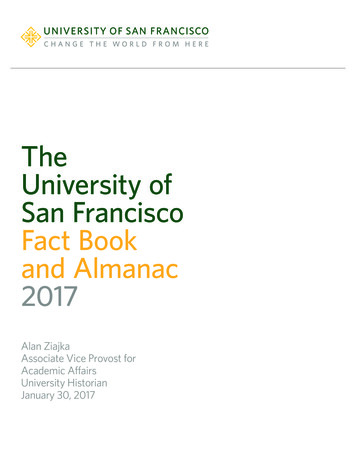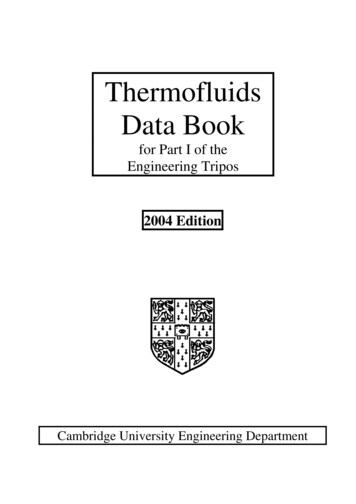
Transcription
ThermofluidsData Bookfor Part I of theEngineering Tripos2004 EditionCambridge University Engineering Department
THERMOFLUIDS DATA version 13.docCONTENTSThermodynamic definitions & relationships. 2Ideal gas relationships . 3Perfect gas relationships. 3Mixtures of perfect gases . 3Non-dimensional groups . 4Heat transfer. 5Equations for systems . 6Equations for control volumes . 7Equations for streamlines. 9Incompressible viscous pipe flow . 9Equations of motion in differential form for viscous steady flow of a fluid. 9Thermodynamic efficiencies. 10Combustion . 11Properties of perfect gases . 12Molar enthalpies of common gases at low pressures . 13Thermochemical data for equilibrium reactions . 14Data for steam . 16Triple point data for steam . 16Critical point data for steam. 16Properties of saturated water & steam: Temperatures from the triple point to the critical point. 17Properties of saturated water & steam: Pressures from the triple point to the critical point. 19Specific enthalpy of water and steam. 23Specific Entropy of water and steam . 24Density of water and steam . 25Specific internal energy of water and steam . 26Transport properties of saturated water & steam . 27Transport properties of steam . 28Transport properties of air. 28Transport properties of carbon dioxide. 29Transport properties of hydrogen. 29Perfect gas relations for compressible flow for γ 1.4. 30Properties of gases at sea level conditions . 31Properties of liquids at sea level conditions. 31The International Standard Atmosphere . 31Properties of the International Standard Atmosphere at altitude . 32Physical constants . 33Conversion of Non-SI to SI Units. 34Conversion of Non-SI to SI Units cont. 35Sources of Information. 36Critical point data for Refrigerant R-134a (CH2FCF3) . 36Properties Table for Refrigerant R-134a (CH2FCF3). 37Properties Chart for Refrigerant R-134a (CH2FCF3). 38Properties of steam. 3906/09/041
THERMOFLUIDS DATA version 13.docTHERMODYNAMIC DEFINITIONS & RELATIONSHIPSSpecific enthalpyh u pvSpecific heat capacity at constant volume§ u ·cv T ¹ vSpecific heat capacity at constant pressure§ h ·cp T ¹ pRatio of specific heat capacitiesγ Coefficient of volume expansionβ Coefficient of compressibilityκ For a simple compressible substance, in the absenceof capillarity, electric and magnetic fieldsTds du pdv dh vdp06/09/04cpcv1 § v · v T ¹ p1 § v · v p ¹T2
THERMOFLUIDS DATA version 13.docIDEAL GAS RELATIONSHIPSEquation of state pV nR T pV mRT pv RT p ρRTRelationship between c p , cv and Rc p cv RSpeed of sounda γRTPERFECT GAS RELATIONSHIPSChange in specific internal energyu2 u1 cv (T2 T1 )Change in specific enthalpyh2 h1 c p (T2 T1 )Change in specific entropy § T2 ·§ v2 · cv ln R ln T1 ¹ v1 ¹ §p ·§T ·s 2 s1 c p ln 2 R ln 2 p1 ¹ T1 ¹ § p2 ·§v · c p ln 2 cv ln p1 ¹ v1 ¹ pvγ const.Tvγ 1 const.T / p (γ 1) γ const.For Isentropic changesMIXTURES OF PERFECT GASESFor a mixture of N perfect gases where, for component -i, mi mass, pi partial pressure, hi hi(T) partial specific enthalpy, si si(T, pi) partial specific entropy, ni number of molsand the overbar signifies a partial molar quantity:pmixture Pressure of the mixtureH mixture Enthalpy of the mixtureS mixture Entropy of the mixture06/09/043i N pii 1i Ni Ni 1i 1 mi hi ni hii Ni Ni 1i 1 mi si ni si
THERMOFLUIDS DATA version 13.docNON-DIMENSIONAL GROUPSReynolds NumberRe ρVd Vd µνMach NumberM VaFroude NumberFr Prandtl NumberPr Drag CoefficientCD Lift CoefficientCL Skin Friction Coefficientcf Friction Factorf 4c fDischarge CoefficientCd Nusselt NumberNu Grashof NumberGr Stanton NumberSt 06/09/044Vgzµc p λναD1ρV 2 A2L12ρV 2 Aτw1ρV 22m actualm idealhdλgd 3 β Tν2Nuh RePr ρVc p
THERMOFLUIDS DATA version 13.docHEAT TRANSFERConduction, Convection and RadiationRate of heat transfer Q by convection from a body of surface area A(Q hA Tbody Tsurroundings)Rate of heat transfer Q by conduction along a straight bar of cross-sectional area AdTQ λAdx Rate of heat transfer Q by conduction radially in a straight circular bar of length LdTQ λ 2πrLdr1 Rate of heat transfer Q by radiation from a grey body of surface area A and emissivity εQ εQ black εσAT 4where σ 5.67x10-8 Wm-2K-4 is the Stefan-Boltzmann constant.Logarithmic-Mean Temperature Difference (LMTD) Tm T1 T2ln ( T1 T2 )Convective heat transfer for fully developed flow in circular pipes of diameter dOverall heat transfer for laminar flow with constant wall temperatureNu d 3.66Red 23000.1 PrOverall heat transfer for turbulent flow with constant wall temperatureNu d 0.023Red0.8 Pr 0.42300 Red 10 70.5 Pr 120Heat transfer due to natural convection from a vertical isothermal plate of height LOverall heat transferNu L 0.52(GrPr )0.25Pr 1Reynolds AnalogySt 1cf2Note that the net rate of heat transfer will be less due to incident radiation06/09/045
THERMOFLUIDS DATA version 13.docEQUATIONS FOR SYSTEMSDefinition of a systemA system is a fixed quantity of matter.Conservation of mass applied to a systemThe mass of a system is constant, i.e.m const.1st Law of Thermodynamics applied to a systemWhen heat transfer to, and work done by, a system are defined as positive and the system isundergoing a cyclic process³ dQ ³ dWWhen heat transfer to, and work done by, a system of mass m undergoing a process betweenstate 1 and state 2 are defined as positive and in the absence of capillarity, electric and magneticfieldsQ W E 2 E1 (U 2 1 2 mV22 mgz 2 ) (U1 1 2 mV12 mgz1 )2nd Law of Thermodynamics applied to a systemWhen heat transfer to a system undergoing a cyclic process is defined as positive, the Clausiusinequality is³dQ 0TWhen heat transfer to a system of mass m undergoing a process is defined as positivedQ mdsirrevwhere dsirrev 0Twhere dsirrev is the entropy created per unit mass by irreversibilities.mds pdv work for a systemWhen the surface of a system undergoes displacement between state 1 and state 2 and thepressure causing the displacement is known over the entire surface that is displaced, thedisplacement work done by the system during this process is2W ³ pdV106/09/046
THERMOFLUIDS DATA version 13.docEQUATIONS FOR CONTROL VOLUMESDefinition of a control volumeA control volume is that region of space that is enclosed by a rigid control surface.The requirements for steady flow within a control volumeFor steady-flow, conditions within the control volume are not, on average, changing so that themass, momentum, energy and entropy within the control volume remain constant.Conservation of mass applied to a control volume - the Continuity EquationIn general, this may be written in vector form asdρdV ³³ ρV dA 0dt ³³³cvcswhere dA is positive out of the control volume. It may also be written asdmcv m out m in 0dtFor steady flow, the above becomes m out m inMomentum equations applied to a control volume, including the Steady Flow MomentumEquation (SFME)In general, this may be written in vector form asdρV dV ³³ ρV V dA F ³³ p dAdt ³³³cvcscswhere dA is positive out of the control volume and F is the sum of all the non-pressure forceson the flow.For steady flow, the above becomes the Steady Flow Momentum Equation (SFME)³³ ρV V dA F ³³ pdAcscsand in x and y coordinates, the SFME is m outVx,out m inVx,in Fx ( pA)x m outV y, out m inV y,in Fy ( pA)ywhere care is needed with respect to the sign of the Vx , V y and A terms.06/09/047
THERMOFLUIDS DATA version 13.doc1st Law of Thermodynamics applied to a control volume, including the Steady Flow EnergyEquation (SFEE)In the absence of capillarity, electric and magnetic fields, the 1st Law becomes)()(dEcv1 21 m out hout Vout gz out m in hin Vin2 gzin Q W x22dtwhere Ecv is the total energy within the control volume, Q is the rate of heat transfer to thecontrol volume and W is the rate of shaft work transferred from the control volume.xFor steady flow, the above becomes the Steady Flow Energy Equation (SFEE)2 gz out ) m in (hin Vin2 gzin ) Q W x m out (hout 2 Vout2112nd Law of Thermodynamics applied to a control volumeWhen heat transfer to a control volume is defined as positivedS cvdQ m out sout m in sin ³ S irrevdtTAwhereS irrev 0where dQ is the rate of heat transfer to an area dA of the control surface at temperature T andthe integration is over the whole area A of the control surface, S cv is the total entropy withinthe control volume and S irrev is the rate of entropy creation within the control volume due toirreversibilities.06/09/048
THERMOFLUIDS DATA version 13.docEQUATIONS FOR STREAMLINESBernoulli's Equation for incompressible inviscid steady flow along a streamlinep 2 ρV 2 ρgz const.1The pressure gradient normal to a streamline with a radius of curvature RVessn,endp ρV 2 RdnRINCOMPRESSIBLE VISCOUS PIPE FLOWThe pressure drop along a pipe of constant diameter d and length L , with viscous flow p 4c fL1L1ρV 2 fρV 2d2d2EQUATIONS OF MOTION IN DIFFERENTIAL FORMFOR VISCOUS STEADY FLOW OF A FLUIDMass conservation (continuity)Intrinsic coordinates ·§ e s e n . ( ȡV e s ) 0 n ¹ sVector Notation . ( ρV ) 0Momentum§ VV 2 · p pes e n e s e n ρ g viscous s R n s ¹Intrinsic coordinatesρ VVector Notationρ V V p ρ g viscous06/09/049
THERMOFLUIDS DATA version 13.docTHERMODYNAMIC EFFICIENCIESEfficiency of a cycleW .QBηcycle netQBbut.WNetW net Q B Q AsoQ .QAηcycle 1 AQBIsentropic efficiencies of compressors and turbinesηc ηt h hIdeal Work Input 2s 1Actual Work Input h2 h1Actual Work Output h3 h4 Ideal Work Outputh3 h4s06/09/0410
THERMOFLUIDS DATA version 13.docCOMBUSTIONThe SFEE applied to stoichiometric combustion at constant T and pWhen heat transfer to a control volume is defined as positive and in the absence of shaft work,changes in KE and PE, cap
THERMOFLUIDS DATA version 13.doc 06/09/04 5 HEAT TRANSFER Conduction, Convection and Radiation Rate of heat transfer Q by convection from a body of surface area A Q hA (T body T surroundin gs) Rate of heat transfer Q by conduction along a straight bar of cross-sectional area A dx dT
